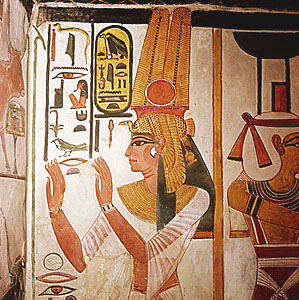The Valley of the Queens is located on the west bank of the Nile. Hidden in a Y-shaped ravine in the western cliffs, the valley served as a necropolis for the tombs of royal family members and the elite. There are almost 90 numbered tombs belonging to queens, princes, and high officials of the New Kingdom (1550-1070 BC). The first member of the royal family to be buried inside the valley was Sitre (QV38) who was the wife of Ramesses I.
An Italian mission from the Turin Museum performed the first scientific excavation of the site during the early 1900s. Ernesto Schiaparelli, an Egyptologist working for the Italian mission, discovered the tomb of Queen Nefertari (QV66) in 1905. Nefertari was one of the five wives of Ramses II. Her tomb is considered as one of the most beautiful and finest tombs in the whole of Egypt. Every centimetre of the walls in the tomb’s three chambers and connecting corridors is adorned with colorful scenes of Nefertari in the company of the gods and with associated text from the Book of the Dead nearby.
The tomb of Nefertari remains closed to the public due to its fragile state. Other well-preserved tombs in the valley include that of Prince Amunhirkhepshef (QV55) (The son of Ramses III who was in his teens when he died), Queen Titi (QV52), and Prince Khaemweset (QV44) who was another son of Ramses III.
In 1979 UNESCO added the Valley of the Queens along with some other sites of Luxor to the World Heritage List.

